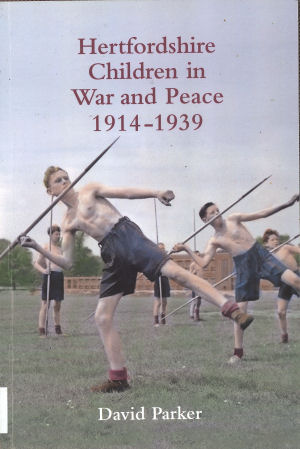 Hertfordshire
Children
Hertfordshire
Children
in War and Peace 1914-1939
David Parker
ISBN 978-1-905313-40-2
This is a well researched and detailed book which will throw a light on how the First World War, and the subsequent peace, affected the education of the parents and grandparents of many of us. When I wrote the book The London Gunners come to Town I looked in some detail at the immediate impact of the war on local schools and my first reaction was too look in the index. There were many entries under Hemel Hempstead, including the following sub entries: Absenteeism from schools, Army camps, Boxmoor CC Mixed School, Central School, Local occupations, Nonconformity, Secondary Schools, Status as an Elementary Authority, and Technical Institute, with more entries under Hemel Hempstead Education Committee. Other towns were equally well covered. A check on some of the entries made me want to read further. I have been caught that way before with library books which are too big to read at one sitting - and ended up paying fines. I have therefore put the book on by "Books to Buy" list and may report further at a later date. In the meantime I give the contents list, and also the list of illustrations. It contains a significant amount of useful information and is a must for anyone researching a school history who wants some relevant background on this period, and some ideas as to where they might find direct references to the their school.
From the Cover
David Parker's new book is a social history of Hertfordshire from the outbreak of the First World War in 1914 to the outbreak of the Second in 1939, with a particular emphasis on the development of education and attitudes towards the young. The period in question shows the people of Hertfordshire going through astonishing change as war and social upheaval convulsed the county.
Being so close to London and yet possessing extensive countryside, during World War I Hertfordshire became virtually one vast training and transit camp. The county also endured German raids. Families and schools suffered significant hardships, and an engrossing story of social trauma and economic turmoil unfolds. The twenties and thirties saw Hertfordshire emerge from Victorian values into the modern world as urban prosperity boomed and rural depression deepened. These were decades of vivid contrasts and significant tensions across the county as rival social groups, political parties, employers and unions strove to make their voices heard.
Among the subjects looked at in detail are the direct effect of military conflict on the county; the evolving situation for children both at school and at work; public health; rural protectionism; the rise of vocationalism in urban schools; and the controversy over Hertfordshire church schools. Taken together, this is a significant contribution to the history of Hertfordshire in the twentieth century.
Contents
| Illustrations | IV | |||
| Abbreviations | XI | |||
| Chapter 1 | Introduction | 1 | ||
| Chapter 2 | Hertfordshire in 1914 | 7 | ||
| Chapter 3 | The direct effects of military conflict | 32 | ||
| Chapter 4 | Schools at war | 63 | ||
| Chapter 5 | Children at work | 97 | ||
| Chapter 6 | The war and health | 125 | ||
| Chapter 7 | Continuity and change: Hertfordshire 1914-1939 | 149 | ||
| Chapter 8 | Education, social class and employment | 176 | ||
| Chapter 9 | The countryside | 207 | ||
| Chapter 10 | The church schools controversy | 236 | ||
| Chapter 11 | A wider view of children's health and welfare 1919-1939 | 264 | ||
| Chapter 12 | Conclusion | 299 | ||
| Endnotes | 307 | |||
| References | 353 | |||
| Index | 363 |
Illustrations
Lea valley greenhouses, c.1927
Paper mills on the river Gade and Grand Junction Canal, c.1927
Boys' class at Letchmore School, Stevenage, c.1910
The Right Honourable Sir Thomas Halsey Bt
Sir John Lovell Pank
The fourth Marquis of Salisbury
The Honourable A.T. Holland-Hibbert
Sir Charles Longmore
The 23rd London Regiment arrives in Hatfield, 1914
Army camp on Royston Heath, 1914
Local families accompany a troop of soldiers in St Albans, c.1914
Troops at the ford, Much Hadham
Troops under canvas in the grounds of Moor Place, Much Hadham
The children's home at Much Hadham, converted into a military convalescent home
Queen's Road School, Royston, converted into a military hospital
The windmill at Much Hadham, disused since 1895, converted into accommodation for Belgian refugees
Lombard House, Hertford: the scene of bombing by a Zeppelin in 1915
Dr (later Lieutenant Colonel Sir) Francis Fremantle
Harpenden war memorial, unveiled by the Earl of Cavan
Map of population growth in Hertfordshire
Birds Hill, Letchworth, c.1927
Aerial view of Welwyn Garden City under development in the 1920s
Sir Edmund Barnard
The Rev. Canon G.H.P. Glossop
Captain Edward Morris
William Graveson, S.W. Howe and R.R. Bunn
Drawing of the proposed Civic College at Letchworth, c.1926
Drawing of the Hall of Memory in the Civic College, c.1926
Wilstone School, c.1910
Wilstone School: spinning
Wilstone School: dyeing wool
Wilstone School: weaving
Gardening class at Letchmore School, Stevenage, c.1923
School garden at Applecroft School, Welwyn Garden City, late 1920s
St Mary's Church of England School, Welwyn
The Right Reverend Michael Bolton Furse, Lord Bishop of St Albans
Kingsmead Special Residential School, formerly Hertford Union Workhouse
| Locating
Books At the time this page was last updated second hand copies were available online |
| November 2010 | Page Created | |
